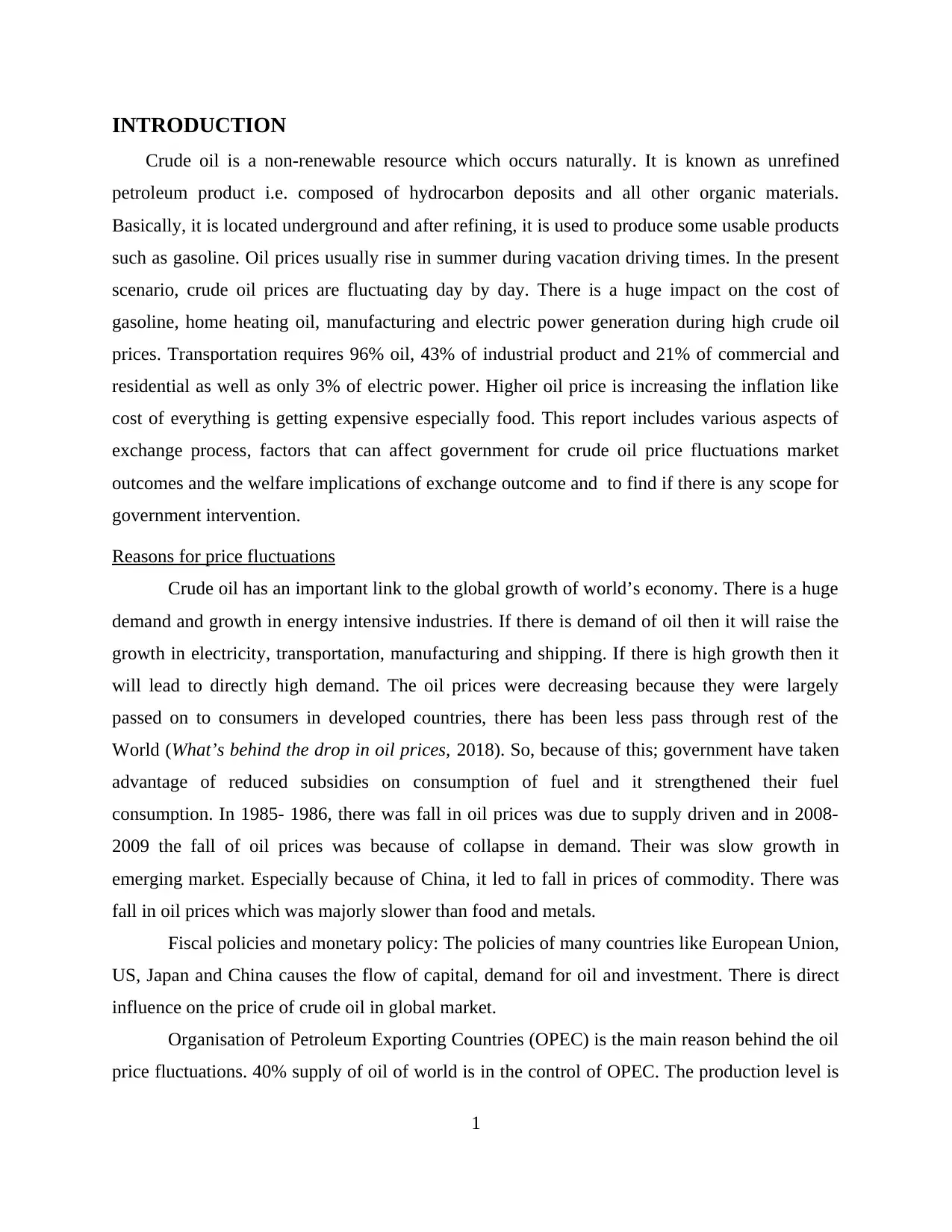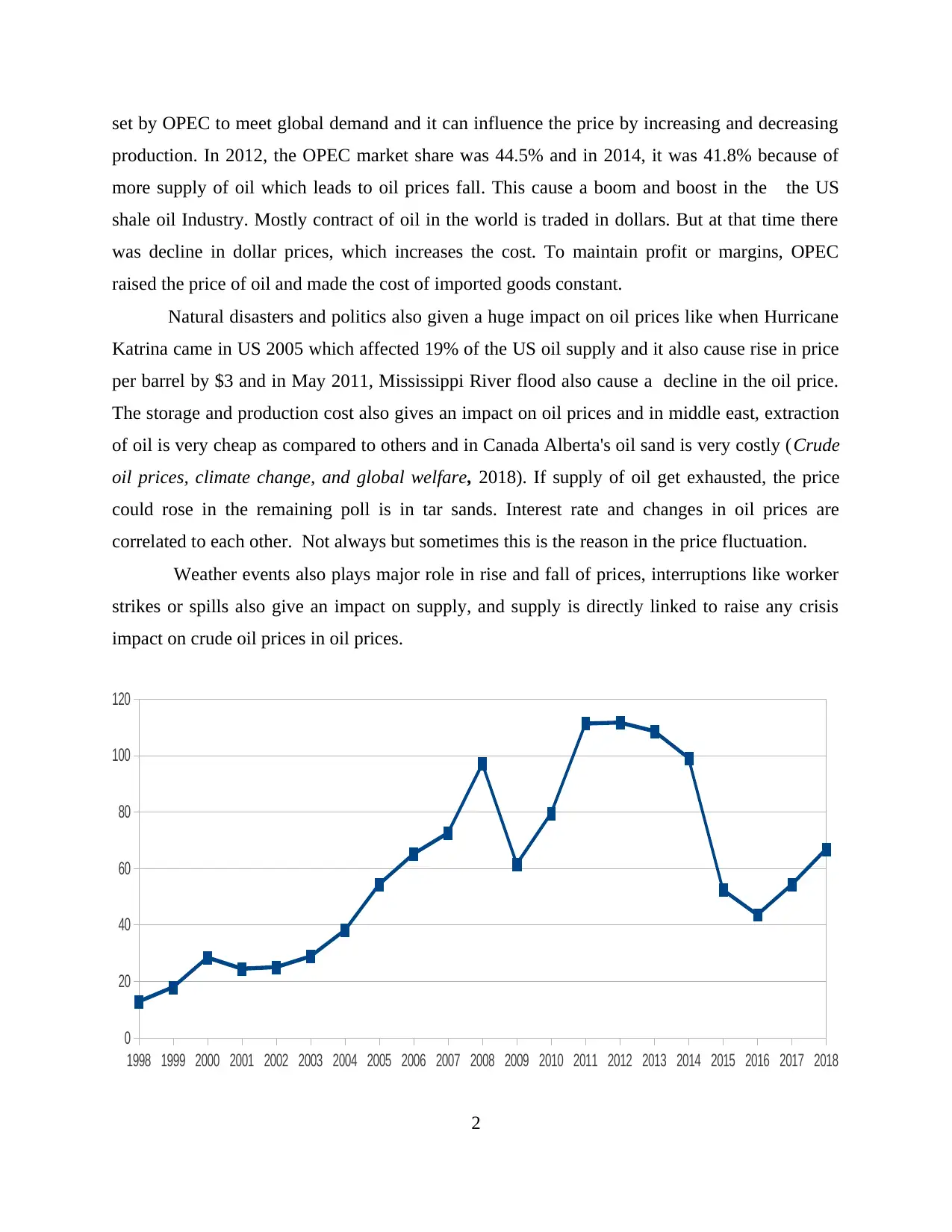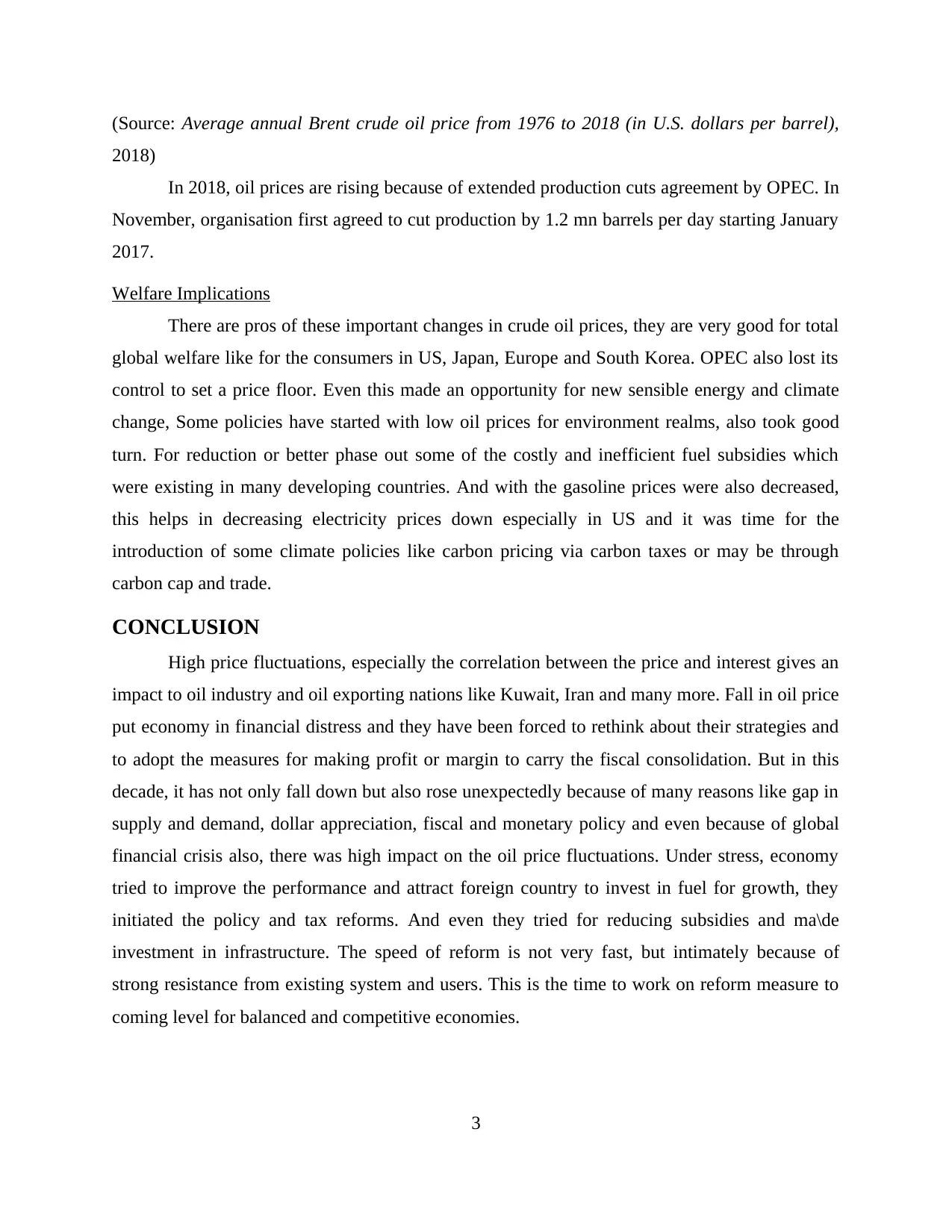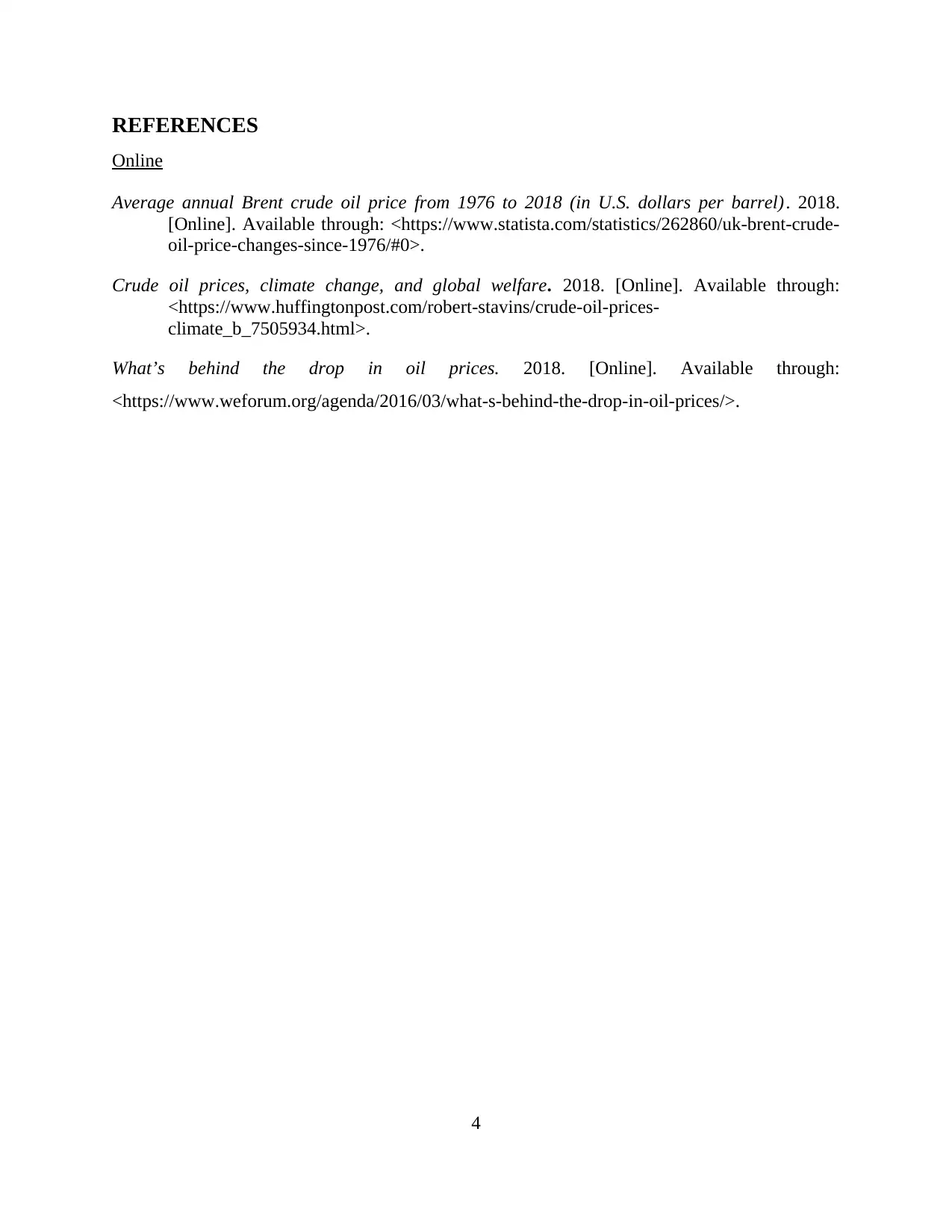Prices and Markets Demand : Assignment
VerifiedAdded on 2021/01/02
|6
|1295
|74
AI Summary
Contribute Materials
Your contribution can guide someone’s learning journey. Share your
documents today.

Prices and Markets
Secure Best Marks with AI Grader
Need help grading? Try our AI Grader for instant feedback on your assignments.

TABLE OF CONTENTS
INTRODUCTION...........................................................................................................................1
Reasons for price fluctuations................................................................................................1
Welfare Implications..............................................................................................................3
CONCLUSION................................................................................................................................3
REFERENCES................................................................................................................................4
INTRODUCTION...........................................................................................................................1
Reasons for price fluctuations................................................................................................1
Welfare Implications..............................................................................................................3
CONCLUSION................................................................................................................................3
REFERENCES................................................................................................................................4

INTRODUCTION
Crude oil is a non-renewable resource which occurs naturally. It is known as unrefined
petroleum product i.e. composed of hydrocarbon deposits and all other organic materials.
Basically, it is located underground and after refining, it is used to produce some usable products
such as gasoline. Oil prices usually rise in summer during vacation driving times. In the present
scenario, crude oil prices are fluctuating day by day. There is a huge impact on the cost of
gasoline, home heating oil, manufacturing and electric power generation during high crude oil
prices. Transportation requires 96% oil, 43% of industrial product and 21% of commercial and
residential as well as only 3% of electric power. Higher oil price is increasing the inflation like
cost of everything is getting expensive especially food. This report includes various aspects of
exchange process, factors that can affect government for crude oil price fluctuations market
outcomes and the welfare implications of exchange outcome and to find if there is any scope for
government intervention.
Reasons for price fluctuations
Crude oil has an important link to the global growth of world’s economy. There is a huge
demand and growth in energy intensive industries. If there is demand of oil then it will raise the
growth in electricity, transportation, manufacturing and shipping. If there is high growth then it
will lead to directly high demand. The oil prices were decreasing because they were largely
passed on to consumers in developed countries, there has been less pass through rest of the
World (What’s behind the drop in oil prices, 2018). So, because of this; government have taken
advantage of reduced subsidies on consumption of fuel and it strengthened their fuel
consumption. In 1985- 1986, there was fall in oil prices was due to supply driven and in 2008-
2009 the fall of oil prices was because of collapse in demand. Their was slow growth in
emerging market. Especially because of China, it led to fall in prices of commodity. There was
fall in oil prices which was majorly slower than food and metals.
Fiscal policies and monetary policy: The policies of many countries like European Union,
US, Japan and China causes the flow of capital, demand for oil and investment. There is direct
influence on the price of crude oil in global market.
Organisation of Petroleum Exporting Countries (OPEC) is the main reason behind the oil
price fluctuations. 40% supply of oil of world is in the control of OPEC. The production level is
1
Crude oil is a non-renewable resource which occurs naturally. It is known as unrefined
petroleum product i.e. composed of hydrocarbon deposits and all other organic materials.
Basically, it is located underground and after refining, it is used to produce some usable products
such as gasoline. Oil prices usually rise in summer during vacation driving times. In the present
scenario, crude oil prices are fluctuating day by day. There is a huge impact on the cost of
gasoline, home heating oil, manufacturing and electric power generation during high crude oil
prices. Transportation requires 96% oil, 43% of industrial product and 21% of commercial and
residential as well as only 3% of electric power. Higher oil price is increasing the inflation like
cost of everything is getting expensive especially food. This report includes various aspects of
exchange process, factors that can affect government for crude oil price fluctuations market
outcomes and the welfare implications of exchange outcome and to find if there is any scope for
government intervention.
Reasons for price fluctuations
Crude oil has an important link to the global growth of world’s economy. There is a huge
demand and growth in energy intensive industries. If there is demand of oil then it will raise the
growth in electricity, transportation, manufacturing and shipping. If there is high growth then it
will lead to directly high demand. The oil prices were decreasing because they were largely
passed on to consumers in developed countries, there has been less pass through rest of the
World (What’s behind the drop in oil prices, 2018). So, because of this; government have taken
advantage of reduced subsidies on consumption of fuel and it strengthened their fuel
consumption. In 1985- 1986, there was fall in oil prices was due to supply driven and in 2008-
2009 the fall of oil prices was because of collapse in demand. Their was slow growth in
emerging market. Especially because of China, it led to fall in prices of commodity. There was
fall in oil prices which was majorly slower than food and metals.
Fiscal policies and monetary policy: The policies of many countries like European Union,
US, Japan and China causes the flow of capital, demand for oil and investment. There is direct
influence on the price of crude oil in global market.
Organisation of Petroleum Exporting Countries (OPEC) is the main reason behind the oil
price fluctuations. 40% supply of oil of world is in the control of OPEC. The production level is
1

set by OPEC to meet global demand and it can influence the price by increasing and decreasing
production. In 2012, the OPEC market share was 44.5% and in 2014, it was 41.8% because of
more supply of oil which leads to oil prices fall. This cause a boom and boost in the the US
shale oil Industry. Mostly contract of oil in the world is traded in dollars. But at that time there
was decline in dollar prices, which increases the cost. To maintain profit or margins, OPEC
raised the price of oil and made the cost of imported goods constant.
Natural disasters and politics also given a huge impact on oil prices like when Hurricane
Katrina came in US 2005 which affected 19% of the US oil supply and it also cause rise in price
per barrel by $3 and in May 2011, Mississippi River flood also cause a decline in the oil price.
The storage and production cost also gives an impact on oil prices and in middle east, extraction
of oil is very cheap as compared to others and in Canada Alberta's oil sand is very costly (Crude
oil prices, climate change, and global welfare, 2018). If supply of oil get exhausted, the price
could rose in the remaining poll is in tar sands. Interest rate and changes in oil prices are
correlated to each other. Not always but sometimes this is the reason in the price fluctuation.
Weather events also plays major role in rise and fall of prices, interruptions like worker
strikes or spills also give an impact on supply, and supply is directly linked to raise any crisis
impact on crude oil prices in oil prices.
2
1998 1999 2000 2001 2002 2003 2004 2005 2006 2007 2008 2009 2010 2011 2012 2013 2014 2015 2016 2017 2018
0
20
40
60
80
100
120
production. In 2012, the OPEC market share was 44.5% and in 2014, it was 41.8% because of
more supply of oil which leads to oil prices fall. This cause a boom and boost in the the US
shale oil Industry. Mostly contract of oil in the world is traded in dollars. But at that time there
was decline in dollar prices, which increases the cost. To maintain profit or margins, OPEC
raised the price of oil and made the cost of imported goods constant.
Natural disasters and politics also given a huge impact on oil prices like when Hurricane
Katrina came in US 2005 which affected 19% of the US oil supply and it also cause rise in price
per barrel by $3 and in May 2011, Mississippi River flood also cause a decline in the oil price.
The storage and production cost also gives an impact on oil prices and in middle east, extraction
of oil is very cheap as compared to others and in Canada Alberta's oil sand is very costly (Crude
oil prices, climate change, and global welfare, 2018). If supply of oil get exhausted, the price
could rose in the remaining poll is in tar sands. Interest rate and changes in oil prices are
correlated to each other. Not always but sometimes this is the reason in the price fluctuation.
Weather events also plays major role in rise and fall of prices, interruptions like worker
strikes or spills also give an impact on supply, and supply is directly linked to raise any crisis
impact on crude oil prices in oil prices.
2
1998 1999 2000 2001 2002 2003 2004 2005 2006 2007 2008 2009 2010 2011 2012 2013 2014 2015 2016 2017 2018
0
20
40
60
80
100
120
Secure Best Marks with AI Grader
Need help grading? Try our AI Grader for instant feedback on your assignments.

(Source: Average annual Brent crude oil price from 1976 to 2018 (in U.S. dollars per barrel),
2018)
In 2018, oil prices are rising because of extended production cuts agreement by OPEC. In
November, organisation first agreed to cut production by 1.2 mn barrels per day starting January
2017.
Welfare Implications
There are pros of these important changes in crude oil prices, they are very good for total
global welfare like for the consumers in US, Japan, Europe and South Korea. OPEC also lost its
control to set a price floor. Even this made an opportunity for new sensible energy and climate
change, Some policies have started with low oil prices for environment realms, also took good
turn. For reduction or better phase out some of the costly and inefficient fuel subsidies which
were existing in many developing countries. And with the gasoline prices were also decreased,
this helps in decreasing electricity prices down especially in US and it was time for the
introduction of some climate policies like carbon pricing via carbon taxes or may be through
carbon cap and trade.
CONCLUSION
High price fluctuations, especially the correlation between the price and interest gives an
impact to oil industry and oil exporting nations like Kuwait, Iran and many more. Fall in oil price
put economy in financial distress and they have been forced to rethink about their strategies and
to adopt the measures for making profit or margin to carry the fiscal consolidation. But in this
decade, it has not only fall down but also rose unexpectedly because of many reasons like gap in
supply and demand, dollar appreciation, fiscal and monetary policy and even because of global
financial crisis also, there was high impact on the oil price fluctuations. Under stress, economy
tried to improve the performance and attract foreign country to invest in fuel for growth, they
initiated the policy and tax reforms. And even they tried for reducing subsidies and ma\de
investment in infrastructure. The speed of reform is not very fast, but intimately because of
strong resistance from existing system and users. This is the time to work on reform measure to
coming level for balanced and competitive economies.
3
2018)
In 2018, oil prices are rising because of extended production cuts agreement by OPEC. In
November, organisation first agreed to cut production by 1.2 mn barrels per day starting January
2017.
Welfare Implications
There are pros of these important changes in crude oil prices, they are very good for total
global welfare like for the consumers in US, Japan, Europe and South Korea. OPEC also lost its
control to set a price floor. Even this made an opportunity for new sensible energy and climate
change, Some policies have started with low oil prices for environment realms, also took good
turn. For reduction or better phase out some of the costly and inefficient fuel subsidies which
were existing in many developing countries. And with the gasoline prices were also decreased,
this helps in decreasing electricity prices down especially in US and it was time for the
introduction of some climate policies like carbon pricing via carbon taxes or may be through
carbon cap and trade.
CONCLUSION
High price fluctuations, especially the correlation between the price and interest gives an
impact to oil industry and oil exporting nations like Kuwait, Iran and many more. Fall in oil price
put economy in financial distress and they have been forced to rethink about their strategies and
to adopt the measures for making profit or margin to carry the fiscal consolidation. But in this
decade, it has not only fall down but also rose unexpectedly because of many reasons like gap in
supply and demand, dollar appreciation, fiscal and monetary policy and even because of global
financial crisis also, there was high impact on the oil price fluctuations. Under stress, economy
tried to improve the performance and attract foreign country to invest in fuel for growth, they
initiated the policy and tax reforms. And even they tried for reducing subsidies and ma\de
investment in infrastructure. The speed of reform is not very fast, but intimately because of
strong resistance from existing system and users. This is the time to work on reform measure to
coming level for balanced and competitive economies.
3

REFERENCES
Online
Average annual Brent crude oil price from 1976 to 2018 (in U.S. dollars per barrel). 2018.
[Online]. Available through: <https://www.statista.com/statistics/262860/uk-brent-crude-
oil-price-changes-since-1976/#0>.
Crude oil prices, climate change, and global welfare. 2018. [Online]. Available through:
<https://www.huffingtonpost.com/robert-stavins/crude-oil-prices-
climate_b_7505934.html>.
What’s behind the drop in oil prices. 2018. [Online]. Available through:
<https://www.weforum.org/agenda/2016/03/what-s-behind-the-drop-in-oil-prices/>.
4
Online
Average annual Brent crude oil price from 1976 to 2018 (in U.S. dollars per barrel). 2018.
[Online]. Available through: <https://www.statista.com/statistics/262860/uk-brent-crude-
oil-price-changes-since-1976/#0>.
Crude oil prices, climate change, and global welfare. 2018. [Online]. Available through:
<https://www.huffingtonpost.com/robert-stavins/crude-oil-prices-
climate_b_7505934.html>.
What’s behind the drop in oil prices. 2018. [Online]. Available through:
<https://www.weforum.org/agenda/2016/03/what-s-behind-the-drop-in-oil-prices/>.
4
1 out of 6
Related Documents
Your All-in-One AI-Powered Toolkit for Academic Success.
+13062052269
info@desklib.com
Available 24*7 on WhatsApp / Email
![[object Object]](/_next/static/media/star-bottom.7253800d.svg)
Unlock your academic potential
© 2024 | Zucol Services PVT LTD | All rights reserved.





